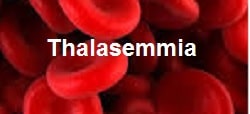Thalassemia
Thalassemia
Thalassemia is a congenital defect in which the blood cells have less than normal haemoglobin.Haemoglobin is essential protein in the blood cells that allow RBCs to carry oxygen and give it to the tissues. Thalassemia can be mild or severe. Mainly two types of thalassemia are there which are;
- Alpha-thalassemia in which alpha chain of haemoglobin is defected either because of single mutant gene or two or three mutant gene. Haemoglobin contain alpha chain which is encoded by 4 genes.
- Beta-thalassemia in which beta chai of haemoglobin is defected either because of one or two mutant genes.
Symptoms
Clinical features depends upon the severity of disease and type of thalassemia. Some major signs and symptoms include;
- Weakness
- Tiredness
- Deformation of facial bones
- Swelling of abdomen
- Pale skin colour
- Growth retardation
- Intense dark colour urine.
Causes
Thalassemia is a genetic disorder so the main cause of development of this condition is the mutation in the gene which is responsible to make haemoglobin.This type of mutation is inherited from parents to children.There are two types of thalassemia. In Alpha-thalassemia clinical features depends upon the number of mutated genes inherited whereas in beta-thalassemia clinical features depends upon the particular part of haemoglobin which is defected.
Complication
Thalassemia can be moderate or severe and can present with following complications;
- Overloading of iron in the body due to repeated blood transfusion. This would lead to the development of deposition of iron in heart, liver and other endocrine glands.
- For the treatment if any patient has undergone spleenectomy risk of infections increases.
- Deformation of bones
- Spleenomegaly
- Retardation of growth.
Diagnosis
Thalassemia is diagnosed in very young age in early two years of life as child presents with characteristic signs and symptoms. Other tests are;
- Blood test. It detect the defect in shape, size and number of blood cells
- Prenatally this condition can be diagnosed by different techniques like; Chorionic villus sampling and Amniocentesis.
Treatment
Treatment options include;
- Frequent need of repeated blood transfusion to cope up severe anemia.
- Iron chelation therapy to remove excess iron from the body and prevent it’s absorption in other tissues.
- Bone Marrow stem cell transplantation.
Home Remedies
- Limit the consumption of excess iron in diet
- Eat healthy organic fruits and vegetables.
- Maintain hygiene and avoid coming in contact with ill persons to avoid infections.
